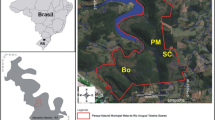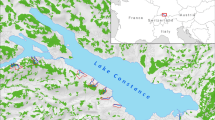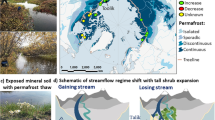Abstract
Sugi (Cryptomeria japonica D. Don) is one of the most important evergreen coniferous plantation species in Japan. Much of the riparian forest that was originally dominated by deciduous broadleaf trees has been converted into sugi plantations. The present study investigated the seasonality of leaf-litter input and leaf dispersal to streams to assess the effects of converting riparian forest to sugi plantations. The seasonality of leaf-litter input was assessed at three streams in Nagoya University Forest. At one stream dominated by deciduous broadleaf trees, input was limited to autumn. At two streams in a sugi plantation, input was prolonged from autumn to early spring, and was dominated by sugi needles from winter to early spring. These results suggest that sugi plantations alter the seasonality of leaf-litter input from riparian forests and affect stream ecosystems. Leaf dispersal was assessed by considering the relationship between leaf dispersal distance from three forest layers to the stream and leaf-litter input into two streams. The maximum leaf dispersal distance was 26–28 m for deciduous broadleaf trees from mid-October to November and 10–12 m for sugi needles from December to April. Leaf dispersal distance depended on the tree species. Four species of deciduous broadleaf tree showed greater leaf dispersal than that of sugi. The mean weight of individual sugi needles was higher than that of the broadleaf trees’ leaves, and dispersal depended on strong winds in winter and early spring. Although the leaf dispersal distance from the understory was within 2–4 m, it could be a significant source of leaf-litter input to streams.






Similar content being viewed by others
References
Abe, T., T. Sakamoto, H. Tanaka, T. Nobuhiro, N. Kabeya & H. Hagino, 2006. Application of a simple physical model to leaf-litter dispersal in riparian forest. Ecology and Civil Engineering 8: 147–156 (in Japanese).
Abe, T., T. Sakamoto, H. Tanaka, N. Kabeya, T. Nobuhiro, T. Nobuhiro & H. Hagino, 2009. Estimation of downslope leaf-litter transport on a forest floor using artificial leaves. Journal of Japanese Forestry Society 91: 104–110 (in Japanese).
Angradi, T. R., 1997. Hydrologic context and macroinvertebrate community response to floods in an Appalachian headwater stream. American Midland Naturalist 138: 371–386.
Cillero, C., I. Pardo & S. E. López, 1999. Comparisons of riparian vs over stream trap location in the estimation of vertical litterfall inputs. Hydrobiologia 416: 171–179.
Colón-Gaud, C., S. Peterson, M. R. Whiles, S. S. Kilham, K. R. Lips & M. P. Cathy, 2008. Allochthonous litter inputs, organic matter standing stocks, and organic seston dynamics in upland Panamanian streams: potential effects of larval amphibians on organic matter dynamic. Hydrobiologia 603: 301–312.
Cummins, K. W., R. C. Peterson, J. C. Howard, J. C. Wuycheck & V. I. Holt, 1973. The utilization of leaf litter by stream detritivores. Ecology 54: 336–345.
Cummins, K. W., G. L. Spengler, G. M. Ward, R. M. Speaker, R. W. Ovink, D. C. Mahan & R. L. Mattingly, 1980. Processing of confined and naturally entrained leaf litter in a woodland stream ecosystem. Limnology and Oceanography 25: 952–957.
Fisher, S. G. & G. E. Likens, 1973. Energy flow in Bear Brook, New Hampshire: an integrative approach to stream ecosystem metabolism. Ecological Monographs 43: 421–439.
Funada, S., C. Yoshimura, H. Ishidaira & K. Takeuchi, 2009. Observation of leaf-litter movement by using RFID tags. Hydrology in Mountain Regions: Observations, Process and Dynamics (IAHS Publication) 326: 139–143.
Haibara, K. & Y. Aiba, 1982. The nutrient circulation and budget for a small catchment basin of an established Sugi (Cryptomeria japonica D. Don) and Hinoki (Chamaecyparis obtusa S. et Z.) stand. Journal of Japanese Forestry Society 64: 8–14.
Ichikawa, T., T. Takahashi & Y. Asano, 2006. Comparison of changes in organic matter dynamics due to stand age between artificial Japanese cedar (Cryptomeria japonica D. Don) forests and Japanese cypress (Chamaecyparis obtusa Sieb. et Zucc.) forests. Journal of Japanese Forestry Society 88: 525–533.
Kaneko, N., S. Katagiri, H. Yamashita, N. Kitaoka & A. Tominaga, 1997. A longterm observation of litterfall of Japanese Red Cedar in Sanbe Experimental Forest of Shimane University. Bulletin of the Faculty of Life and Environmental Science, Shimane University 2: 7–13 (in Japanese).
Katagiri, S., N. Kaneko & Y. Obatake, 1990. Nutrient cycling in a Sugi (Cryptomeria japonica D. Don) stand with insufficient management—nutrient accumulation in aboveground and soil and nutrient return by litterfall and rainfall. Bulletin of the Faculty of Agriculture, Shimane University 24: 21–27 (in Japanese).
Kochi, K., S. Yanai & A. Nagasaka, 2004. Energy input from a riparian forest into a headwater stream in Hokkaido, Japan. Archive für Hydrobiologie 160: 231–246.
Kochi, K., Y. Mishima & A. Nagasaka, 2010. Lateral input of particulate organic matter from bank slopes surpasses direct litter fall in the uppermost reaches of a headwater stream in Hokkaido, Japan. Limnology 11: 77–84.
Komatsu, H., T. Kume & K. Otsuki, 2008. The effect of converting a native broad-leaved forest to a coniferous plantation forest on annual water yield: a paired-catchment study in northern Japan. Forest Ecology and Management 255: 880–886.
Komiyama, A., 1991. Relationships between stem-diameter growth periods and leaf growth periods of deciduous broadleaved tree species with reference to environmental factors. Journal of Japanese Forestry Society 73: 409–418 (in Japanese).
Mathooko, J. M., G. O. Morara & M. Leichtfried, 2001. Leaf litter transport and retention in a tropical Rift Valley stream: an experimental approach. Hydrobiologia 443: 9–18.
McArthur, J. V., J. R. Barnes, B. J. Hanson & L. G. Leff, 1988. Seasonal dynamics of leaf litter breakdown in a Utah alpine stream. Journal of the North American Benthological Society 7: 44–50.
Miyaura, T., 1987. Litterfall in a sugi (Cryptomeria japonica D. Don) plantation. Transactions of the 98th Meeting of Japanese Forestry Society 293–294 (in Japanese).
Orndorff, K. A. & G. E. Lang, 1981. Leaf litter redistribution in a West Virginia Hardwood Forest. Journal of Ecology 69: 225–235.
Ota, I., 2007. A forest owners’ cooperative in Japan: obtaining benefits of certification for small-scale forests. Unasylva 58: 64–66.
Pozo, J., E. González, J. R. Díez, J. Molinero & A. Elósegui, 1997. Inputs of particulate organic matter to streams with different riparian vegetation. Journal of the North American Benthological Society 16: 602–611.
Richardson, J. S., 1991. Seasonal food limitation of detritivores in a montane stream: an experimental test. Ecology 72: 873–887.
Robinson, C. T. & G. W. Minshall, 1986. Effects of disturbance frequency on stream benthic community structure in relation to canopy cover and season. Journal of the North American Benthological Society 5: 237–248.
Saito, H. & T. Shidei, 1973. Studies on the productivity and its estimation methodology in a young stand of Cryptomeria japonica D. Don. Journal of the Japanese Forest Society 71: 69–73 (in Japanese).
Scrimgeour, G. J. & M. J. Winterbourn, 1989. Effects of floods on epilithon and benthic macroinvertebrate populations in an unstable New Zealand river. Hydrobiologia 171: 33–44.
Simon, K. S. & E. F. Benfield, 2001. Leaf and wood breakdown in cave streams. Journal of the North American Benthological Society 20: 550–563.
Stone, D. M., 1977. Leaf dispersal in a pole-size maple stand. Canadian Journal of Forest Research 7: 189–192.
Takahashi, K., S. Hayashi, F. Nakamura, T. Tsuji, S. Tsuchiya & H. Imaizumi, 2003. A review on buffer width required for ecological functions of riparian forests. Ecology and Civil Engineering 5: 139–167.
Tsukada, M., 1982. Cryptomeria japonica: glacial refugia and late-glacial and postglacial migration. Ecology 63: 1091–1105.
Tsumura, Y. & K. Ohba, 1993. Benetic structure of geographical marginal populations of Cryptomeria japonica. Canadian Journal of Forest Research 23: 859–863.
Wallace, J. B., M. R. Whiles, S. Eggert, T. F. Cuffney, G. J. Lugthart & K. Chung, 1995. Long-term dynamics of coarse particulate organic matter in three Appalachian Mountain streams. Journal of the North American Benthological Society 14: 217–232.
Webster, J. R. & E. F. Benfield, 1986. Vascular plant breakdown in freshwater ecosystems. Annual Review of Ecology and Systematics 17: 567–594.
Welbourn, M. L., E. L. Stone & J. P. Lassoie, 1981. Distribution of net litter inputs with respect to slope position and wind direction. Forest Science 27: 651–659.
Yoshida, T., 2006. Spatiotemporal structure of resource dynamics and microarthropod communities in detrital food webs in a Cryptomeria japonica forest. Nagoya University Forest Science 25: 107–153 (in Japanese).
Acknowledgments
The authors thank the members of the Laboratory of Forest Resources Utilization and Nagoya University Forest facility for designing the research and for advice regarding the discussion. Yuji Tokumoto and Megumi Yoshida helped to spray crowns.
Author information
Authors and Affiliations
Corresponding author
Additional information
Handling editor: B. Oertli
Rights and permissions
About this article
Cite this article
Kanasashi, T., Hattori, S. Seasonal variation in leaf-litter input and leaf dispersal distances to streams: the effect of converting broadleaf riparian zones to conifer plantations in central Japan. Hydrobiologia 661, 145–161 (2011). https://doi.org/10.1007/s10750-010-0520-4
Received:
Revised:
Accepted:
Published:
Issue Date:
DOI: https://doi.org/10.1007/s10750-010-0520-4




